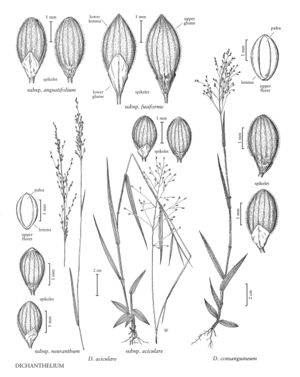Dichanthelium aciculare subsp. angustifolium
Synonyms: Panicum arenicoloides Panicum angustifolium Panicum aciculare var. angustifoliutn
Treatment appears in FNA Volume 25. Treatment on page 444.
Plants cespitose. Culms usually 35-75 cm, usually pubescent, at least on the lower internodes. Midculm blades 6-16 cm, usually glabrous. Primary panicles open, branches spreading, not appearing 1-sided. Spikelets 2.4-3 mm, narrowly obovoid to ellipsoid, often pointed to beaked. Lower glumes attached less than 0.2 mm below the upper glumes.
Discussion
Dichanthelium aciculare subsp. angustifolium grows in open pine woodlands, often in sandy soil with needle duff. It is restricted to the southeastern United States.
Selected References
None.
Lower Taxa
None.
"usually distinctly longer and narrower" is not a number."decumbent" is not a number.
... more about "Dichanthelium aciculare subsp. angustifolium"
absent +
common +
absent +
bulliform +
absent +
membranous +
absent +
absent +
arising +
single +
winter +
differentiated +
cormlike +
attenuate +
narrow +
hard +
thick +
transitional +
cluster +
distinct +
adaxial +
involute +
narrow +
rebranching +
spreading +
absent +
sterile +
spikelike +
absent +
sterile +
not developed +
absent +
longer +
sometimes longer +
branched +
annual +
climbing +
floating +
herbaceous +
flabellate +
pubescent +
woody +
narrow +
1/2 +
waisted +
large +
hard +
capillary +
germination +
adjacent +
sometimes longer +
well-developed +
absent +
reduced +
bisexual +
absent +
gaping +
shorter +
shorter or longer +
upper +
unequal +
membranous +
equal +
papillose-based +
ascending +
absent +
lacking +
uncinate +
punctate +
Present +
axillary +
elongated +
absent +
distichous +
hyaline +
coriaceous +
true +
absent +
membranous +
free +
absent +
inconspicuous +
glabrous +
cuneate +
fleshy +
adjacent +
transitional +
wrinkled +
staminate +
sterile +
reduced +
veined +
attached +
thin +
absent +
thin +
separated +
hyaline +
involute +
absent +
16-25 +
prominent +
glabrous +
absent +
glabrous +
keeled +
subterranean +
absent +
separating +
thin +
contracted +
developing +
well-exserted +
chasmogamous +
evident +
reduced +
cleistogamous +
reduced +
higher +
included +
small +
open +
closed +
shorter +
complex +
bisexual +
unisexual +
sessile +
length +
attached +
absent +
narrow +
varying +
simple +
convex +
Dichanthelium aciculare subsp. angustifolium +
Dichanthelium aciculare +
subspecies +
hyaline +
membranous +
sessile +
apiculate +
bisexual +
plump +
5-11-veined +
not saccate +
slightly shorter +
absent +
subequal +
glabrous +
shiny +
chartaceous-indurate +
absent +
rhizomatous +
grayish-green +
perennial +
herbaceous +
various +
